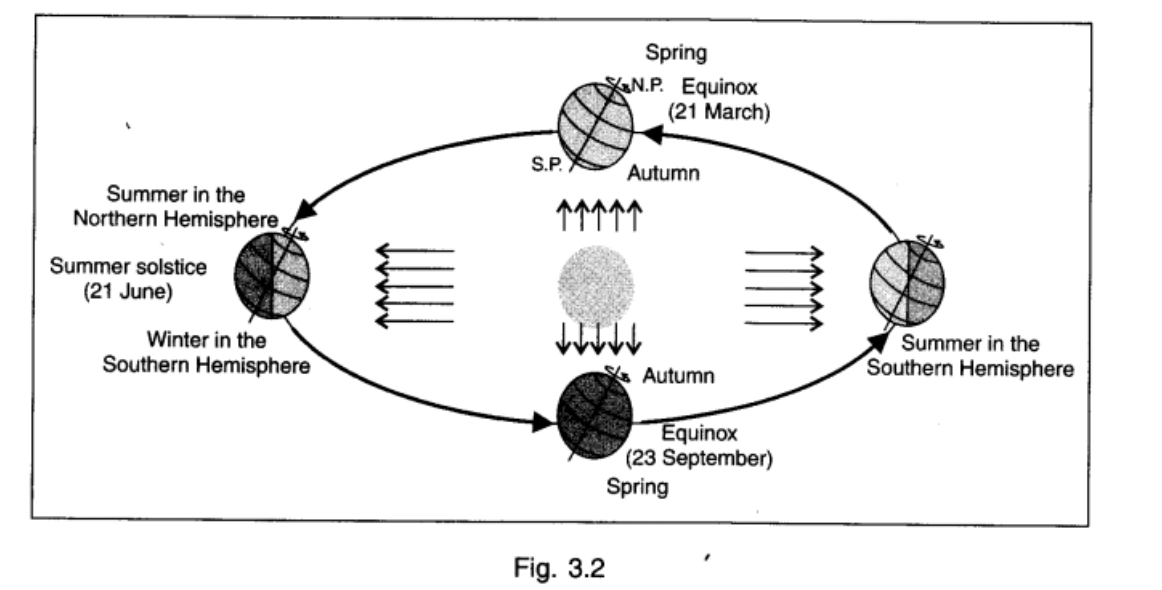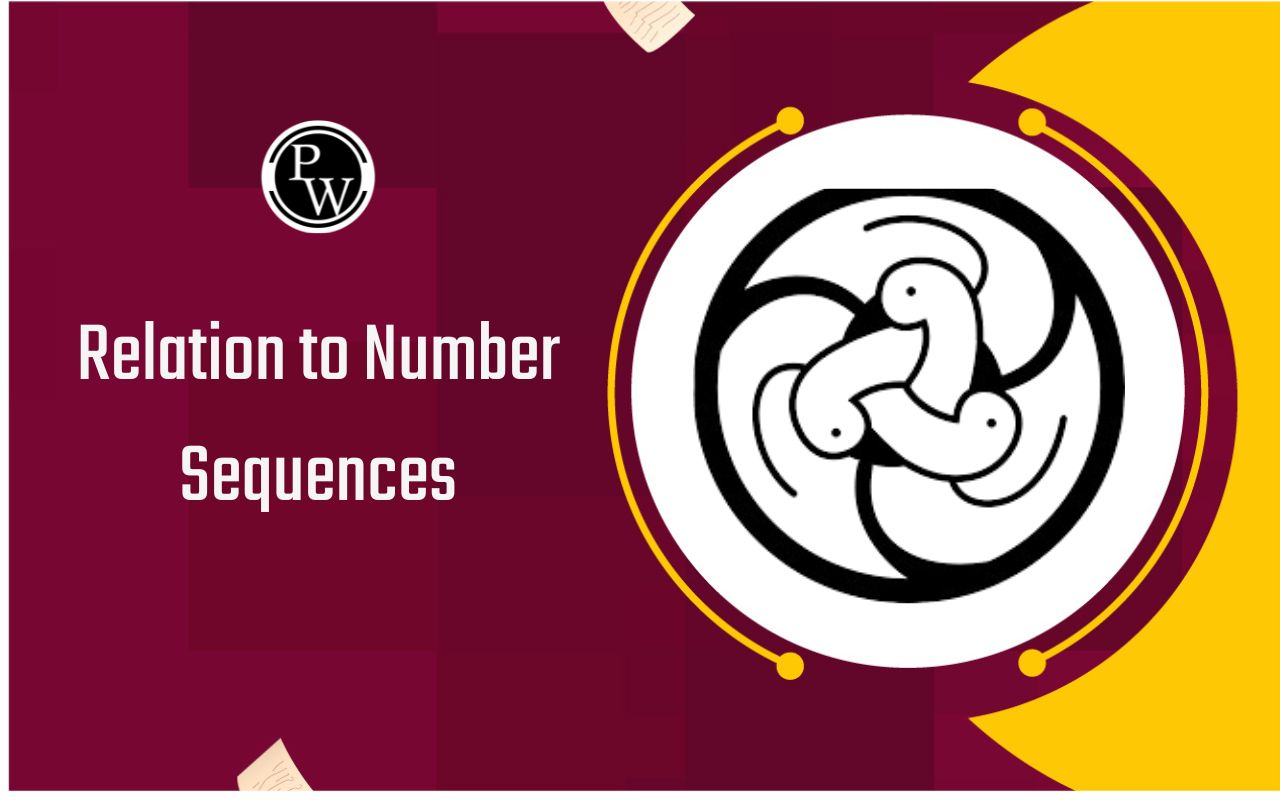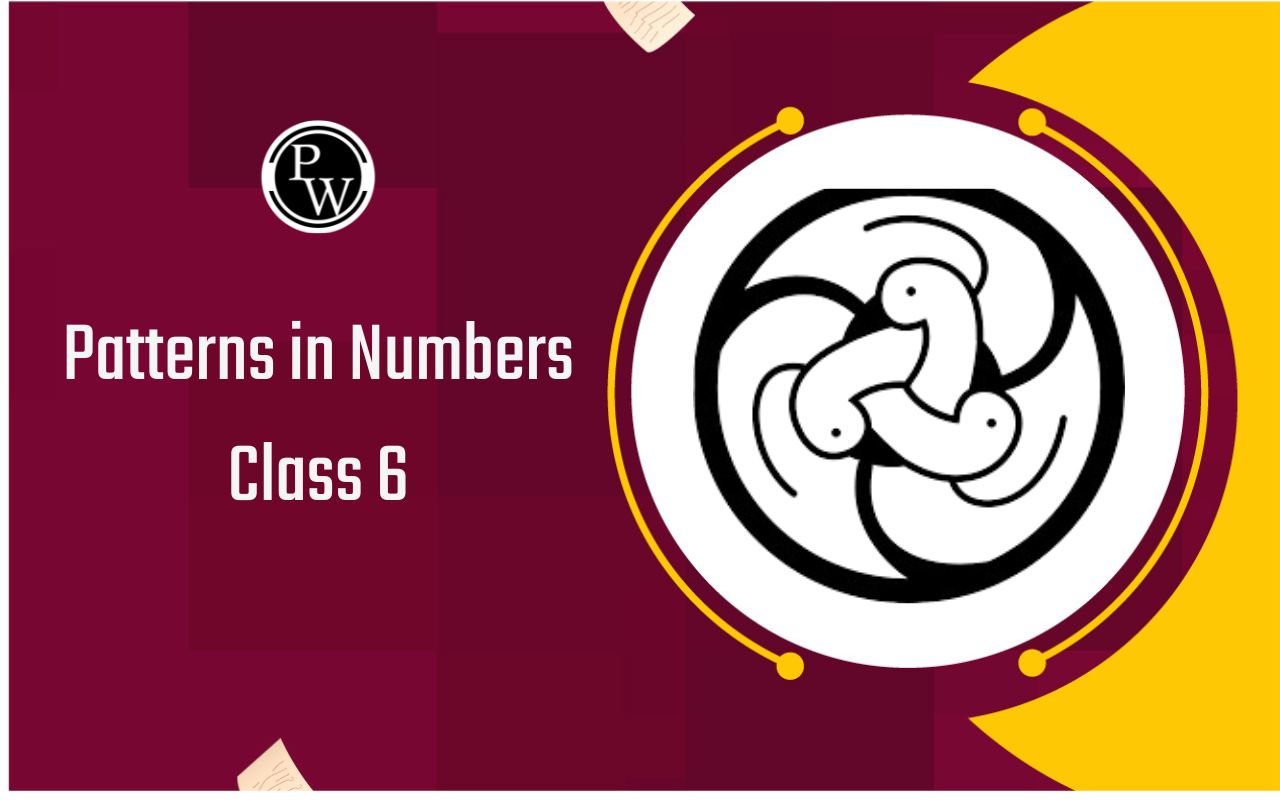
NCERT Solutions for Class 6 Social Science Geography Chapter 3
NCERT Solutions for Class 6 Social Science Geography Chapter 3: The Earth moves in two ways, creating seasons and day-night changes. These movements are rotation, spinning around its own centre, and revolution, circling the Sun. Rotation is like Earth turning around, moving from the west to the east. Revolution is when Earth travels around the Sun in a set path. This motion brings about different seasons in various parts of the Earth. You can check out our NCERT Solutions for Class 6 Social Science Geography Chapter 3. The questions from the book are solved in a clear and step-by-step way for your understanding.NCERT Solutions for Class 6 Social Science Geography Chapter 3 Motions of the Earth
1. Answer the following questions briefly.
(a) What is the angle of inclination of the earth’s axis with its orbital plane? (b) Define rotation and revolution. (c) What is a leap year? (d) Differentiate between the summer solstice and winter solstice. (e) What is an equinox? (f) Why does the Southern Hemisphere experience winter and summer solstice in different times than that of the Northern Hemisphere? (g) Why do the poles experience about six months’ day and six months’ night?Answers:
(a) The angle of inclination of the earth’s axis with its orbital plane is 66 1/2. (b) The movement of the earth on its axis is known as rotation. Revolution. The movement of the earth around the sun in a fixed path or orbit is known as revolution. (c) The year in which February is 29 days instead of 28 days is called a leap year. Thus a leap year is 366 days instead of 365 days. (d) Difference between the summer solstice and winter solstice (e)
Equinox happens on 21st March and 23rd September, when both the hemispheres have the same length of day and night.
(e)
Equinox happens on 21st March and 23rd September, when both the hemispheres have the same length of day and night.
- During 21st March in the Northern hemisphere, it's called spring equinox. But in the Southern hemisphere, it's the autumn equinox.
- On 23rd September, in the Northern hemisphere, it's the autumn equinox, while in the Southern hemisphere, it's the spring equinox.
- On December 22nd, the Southern hemisphere tilts toward the Sun, causing its summer solstice. Meanwhile, the Northern hemisphere experiences winter solstice as it leans away from the Sun during that time.
- Conversely, on June 21st, the Northern hemisphere tilts toward the Sun, resulting in its summer solstice, while the Southern hemisphere has its winter solstice because it tilts away from the Sun during this period.
- During the time when the top part of the Earth is leaning towards the Sun, the North Pole stays in sunlight for the whole day, which is 24 hours. This situation lasts for six months, from March 21st to September 23rd.
- On the other hand, in the bottom part of the Earth, the South Pole doesn't receive sunlight for these six months. As a result, it goes through night time for half a year, from September 23rd to March 21st.
- When the bottom part of the Earth is tilted towards the Sun, the South Pole remains in daylight for 24 hours, lasting for six months from September 23rd to March 21st. The opposite happens at the North Pole, leading to six months of nighttime.
Answers: (a)—(ii), (b)—(i), (c)—(iii), (d)—(ii).
3. Fill in the blanks.- A leap year has ………… a number of days.
- The daily motion of the earth is ……… ……
- The earth travels around the sun in…………….
- The sun’s rays fall vertically on the Tropic of…………….. on 21st June.
- Days are shorter during …………
Answer:
- 366
- rotation
- elliptical
- cancer
- winter

CBSE Board Exam Centre List 2024
Multiple Choice Questions
Choose the correct option to complete the sentences given below: (i) The axis of the earth is a/an…………….. (a) imaginary line (b) straight line (c) curved line (d) real line. (ii) The earth receives light from the …………… (a) Moon (b) Stars (c) Meteors (d) Sun. (iii) The time taken by the earth to complete one rotation around its axis is………………… (a) 24 hours (b) 12 hours (c) 36 hours (d) 18 hours. (iv) The earth completes one revolution in …………… (a) 366 days (b) 370 days (c) 365 1/4 days (d) 366 1/4 days. (v) It is spring in the Northern Hemisphere and autumn in the Southern Hemisphere on …………………………. (a) 23rd September (b) 21st March (c) 22nd December (d) 21st June.Answer: (i)—(a), (ii)—(d), (iii)—(a), (iv)—(c), (v)—(b).
Fill in the Blanks
Fill in the blanks with appropriate words to complete each sentence:- Days and nights occur due to …………… of the earth.
- Only half of the earth gets light from the sun at a time due to its……………. shape.
- The period of rotation is known as the ……………..
- The sun’s rays fall vertically at the Tropic of…………….. on 22nd December.
- On ………… it is the autumn season in the Northern Hemisphere and spring in the Southern Hemisphere.
Answer:
- rotation
- spherical
- earth day
- Capricorn
- 23rd September.
True/False
State whether these sentences are true (T) or false (F).- The earth's axis is tilted at an angle of 23 degrees from its orbital plane.
- Every five years, February has 29 days instead of 28.
- Seasons change because the earth moves around the sun.
- When it's summer in the Northern Hemisphere, it's spring in the Southern Hemisphere.
- Living is not possible in very harsh conditions.
Answer:
- False
- False
- True
- False
- True.
| CBSE Syllabus Class 6 | |
| CBSE Class 6 Science Syllabus | CBSE Class 6 Maths Syllabus |
| CBSE Class 6 Social Science Syllabus | CBSE Class 6 English Syllabus |
Matching Skill
Match the items in column A correctly with those given in column B.
Motions of the Earth Class 6 Geography Chapter 3 Very Short Answer Type Questions
1. Define the circle of illumination.
Answer: The circle that divides the day from night on the globe is known as the circle of illumination. 2. Which motion of the earth is associated with the changes in season? Answer: Revolution. 3. Why do seasons change? [V. Imp.] Answer: Seasons change due to the change in the position of the earth around the sun. 4. Why do the areas near the poles receive less heat? Answer: It is because the rays of the sun are slanting on the poles. 5. When do the longest day and the shortest night occur in the Northern Hemisphere? Answer: On 21st June. 6. In which Hemisphere does Australia lie? Answer: Australia lies in the Southern Hemisphere.Class 6 Geography Chapter 3 NCERT Solutions Short Answer Type Questions
1. What would happen if the earth did not rotate? Imp.]
Answer: In this situation, the part of the Earth facing the sun would always have daylight, leading to ongoing warmth. Meanwhile, the other half would remain in constant darkness, experiencing freezing cold temperatures continuously. These extreme conditions are not suitable for supporting life. Therefore, we can conclude that if the Earth didn't rotate, life wouldn't be possible. 2. How does leap year occur? [V. Imp.] Answer: The Earth needs 365.25 days, or approximately one year, to go around the sun. However, to make things simple, we usually consider a year as having 365 days and leave out the extra six hours. We collect those saved six hours each year and add them up to create an extra day, which equals 24 hours. This bonus day is put into February. So, every four years, February gets 29 days instead of 28. This special year with 366 days is called a leap year. 3. Explain the following with a diagram:(a) Summer solstice (b) Winter solstice (c) Equinox.
 Answer: (a)
Summer solstice happens when the Northern Hemisphere leans towards the sun on June 21st. This makes the Tropic of Cancer directly under the sun's rays, causing those areas to get more warmth. However, places closer to the poles get less heat because the sun's rays come in at an angle. The North Pole tilts towards the sun, giving areas beyond the Arctic Circle constant daylight for about six months.
With a large part of the Northern Hemisphere getting sunlight, it's summer in the areas above the equator. On June 21st, these places experience the longest day and the shortest night. The Southern Hemisphere, on the other hand, has winter during this time, with longer nights and shorter days. This Earth position is called the summer solstice.
(b)
Winter solstice happens on December 22nd. During this time, the Tropic of Capricorn gets direct sunlight because the South Pole leans towards it. When the sun's rays go straight down at the Tropic of Capricorn, more of the Southern Hemisphere gets daylight. So, the Southern Hemisphere has summer with longer days and shorter nights. This specific Earth position is known as the winter solstice.
(c)
On March 21 and September 23, the sun's rays directly hit the equator. During this time, neither of the poles leans toward the sun. Because of this, the whole Earth has the same length of day and night. This event is called an equinox.
Answer: (a)
Summer solstice happens when the Northern Hemisphere leans towards the sun on June 21st. This makes the Tropic of Cancer directly under the sun's rays, causing those areas to get more warmth. However, places closer to the poles get less heat because the sun's rays come in at an angle. The North Pole tilts towards the sun, giving areas beyond the Arctic Circle constant daylight for about six months.
With a large part of the Northern Hemisphere getting sunlight, it's summer in the areas above the equator. On June 21st, these places experience the longest day and the shortest night. The Southern Hemisphere, on the other hand, has winter during this time, with longer nights and shorter days. This Earth position is called the summer solstice.
(b)
Winter solstice happens on December 22nd. During this time, the Tropic of Capricorn gets direct sunlight because the South Pole leans towards it. When the sun's rays go straight down at the Tropic of Capricorn, more of the Southern Hemisphere gets daylight. So, the Southern Hemisphere has summer with longer days and shorter nights. This specific Earth position is known as the winter solstice.
(c)
On March 21 and September 23, the sun's rays directly hit the equator. During this time, neither of the poles leans toward the sun. Because of this, the whole Earth has the same length of day and night. This event is called an equinox.
Find Easy and Section Wise NCERT Solutions for Class 6 Social Science Geography Chapter 3
NCERT Class 6 Social Science Geography Chapter 3, titled "Motions of the Earth," discusses how the Earth moves and interacts with the universe. The Earth has two main motions: rotation and revolution. Rotation happens as the Earth spins around its axis from west once every 24 hours. This spinning is called rotation. Additionally, the Earth revolves around the sun in a fixed path, known as Earth's orbit, taking about 365 ¼ days, which is called revolution. The chapter elaborates on how Earth's rotation functions. Sunlight reaches the Earth, and due to its movement, the part facing the Sun is illuminated, creating day, while the other part in darkness experiences night. If the Earth didn't rotate, one side would have perpetual day with constant warmth, and the opposite side would have perpetual night with continuous cold. Under such circumstances, sustaining life on Earth would have been impossible. The chapter also delves into the Earth's revolution, explaining how the Earth orbits the Sun at a speed of 96000 kilometres per hour. The information includes the concept of changing day and night lengths and the Earth's changing seasons each year. The chapter provides insights into Polar days and nights. During the Northern Hemisphere's summer season (March to September), the North Pole experiences 24 hours of sunlight, and this condition persists for six months. Conversely, during the Southern Hemisphere's summer season (September to March), the North Pole has six-month-long nights. The chapter also details the annual seasons experienced in different parts of the world.NCERT Solutions for Class 6 Social Science Geography Chapter 3 PDF Download
Why Prefer PhysicsWallah’s NCERT Solutions Class 6 Social Science Geography?
Students may wonder why they should choose PhysicsWallah instead of other study resources. The teachers at PhysicsWallah offer quality education and help students with their questions even during the COVID pandemic. So, why not take advantage of this opportunity? We believe that a determined student will always prefer PhysicsWallah for quality education. Additionally, traditional paper books can be expensive, making them unaffordable for many students. PhysicsWallah cares about every determined student with a goal to achieve high marks and excel in exams. PhysicsWallah provides detailed study material and a revised syllabus for Class 6 NCERT Geography books. You can find free solutions for Chapter 3, Motion of the Earth, on PhysicsWallah. It covers all the chapters of Class 6 Geography - The Earth Our Habitat and follows the NCERT syllabus. Choose PhysicsWallah for free PDFs to better understand the concepts.Benefits of NCERT Solutions for Class 6 Social Science Geography Chapter 3
"Motions of the Earth," offer several benefits to students. These solutions are designed to complement the textbook and provide a comprehensive understanding of the topics covered in the chapter. Here are some of the key benefits of using NCERT Solutions for Class 6 Social Science Geography Chapter 3: 1. Clarity of Concepts: NCERT Solutions are crafted in a way that ensures clarity of concepts. They provide detailed explanations for each topic covered in the chapter, helping students understand the fundamental principles of the motions of the Earth. This clarity is essential for building a strong foundation in geography. 2. Systematic Approach: The solutions follow a systematic and well-organised approach to presenting information. This structure aids students in following the logical progression of concepts related to the motions of the Earth, making it easier for them to grasp the subject matter. 3. Accurate Information: NCERT Solutions for Class 6 Social Science Geography are prepared by subject matter experts, ensuring the accuracy of the information provided. Students can rely on these solutions for precise and correct answers to their questions, fostering a trustworthy learning experience. 4. Comprehensive Coverage: The solutions cover all the topics included in Chapter 3, leaving no gaps in the understanding of the motions of the Earth. This comprehensive coverage helps students gain a holistic view of the subject, making it easier for them to tackle questions in exams. 5. Exam Preparation: NCERT Solutions serve as an excellent resource for exam preparation. They include solutions to textbook exercises and additional questions that students may find helpful in reinforcing their understanding of the concepts. This, in turn, enhances their preparation for class tests and examinations. 6. Practice Material: The solutions provide ample practice material, including solved examples and exercises. This allows students to apply the concepts they have learned and reinforces their problem-solving skills. Regular practice with these solutions contributes to a deeper understanding of the subject. 7. Promotes Self-Study: NCERT Solutions encourage self-study among students. The clear explanations and step-by-step solutions empower students to study independently, promoting self-reliance and enhancing their ability to comprehend and solve problems on their own. 8. Alignment with Curriculum: NCERT Solutions are aligned with the curriculum prescribed by educational boards. This ensures that students are learning the content that is relevant to their academic syllabus, helping them stay on track with their coursework.How to Prepare with NCERT Solutions for Class 6 Social Science Geography Chapter 3
If you're preparing for Class 6 Social Science Geography Chapter 3 using NCERT Solutions, here's a step-by-step guide on how you can effectively go through the material and make the most out of your study sessions:Step 1: Familiarise Yourself with the Chapter
- Read the Chapter Thoroughly: Begin by reading Chapter 3 of your Class 6 Social Science Geography textbook. Try to grasp the main concepts and understand the key points.
Step 2: Use NCERT Solutions
- Access the NCERT Solutions Book: Get hold of the NCERT Solutions book for Class 6 Social Science Geography. This book provides detailed answers to the exercises and questions given at the end of each chapter.
- Read the Solutions After Each Exercise/Question: After attempting a question or exercise, refer to the NCERT Solutions book for that specific question. Compare your answer with the given solution. Pay attention to the method of solving problems.
- Understand Concepts: NCERT Solutions not only provide answers but also explanations for each step. Ensure that you understand the underlying concepts thoroughly.
Step 3: Make Notes
- Create a Summary: While going through the NCERT Solutions, create a summary or outline of the key concepts. This could be in the form of bullet points or mind maps.
- Important Formulas and Definitions: Note down any formulas or definitions that are crucial for understanding the chapter. This will serve as a quick reference during revision.
Step 4: Practise More
- Additional Exercises: Apart from the exercises provided in the NCERT book, consider practising additional problems from other sources. This helps in reinforcing your understanding of the concepts.
- Use Reference Books: If you find certain topics challenging, you can consult reference books for Class 6 Geography that provide more detailed explanations and examples.
Step 5: Discuss with Peers or Teachers
- Form Study Groups: Discussing concepts with classmates can provide different perspectives and help solidify your understanding.
- Ask Teachers for Clarification: If you encounter difficulties, don’t hesitate to ask your teacher for clarification. Understanding concepts at this stage is crucial for building a strong foundation.
Step 6: Regular Revision
- Periodic Revision: Schedule regular revision sessions. Revise your notes and go through the solved problems to reinforce your learning.
- Test Yourself: Take self-assessment tests or quizzes related to the chapter. This will help you evaluate your understanding and identify areas that need more attention.
Step 7: Seek Help Online
- Online Resources: There are various online platforms offering additional resources, explanations, and quizzes related to NCERT textbooks. Utilise these resources for extra practice.
Step 8: Stay Organised
- Keep Track of Progress: Maintain a record of the chapters you've covered, the exercises you've completed, and areas that need more focus. This helps in planning your study sessions effectively.
Step 9: Time Management
- Allocate Time for Each Chapter: Plan your study time in such a way that you allocate sufficient time for each chapter. Don’t rush through the material.
Step 10: Stay Positive
- Stay Motivated: Positive reinforcement is crucial. Celebrate small victories and progress. Stay motivated throughout your preparation.
NCERT Solutions for Class 6 Social Science Geography Chapter 3 FAQs
How does the concept of leap year relate to Earth's orbit?
A leap year, with an extra day added in February, compensates for the fact that Earth's orbit around the Sun is not precisely 365 days but about 365.25 days.
Are there any cultural or historical implications of Earth's rotation?
Earth's rotation has influenced the development of calendars, timekeeping systems, and cultural practices related to agriculture and seasonal events.
How do astronauts experience day and night in space?
In space, astronauts aboard the International Space Station experience 16 sunrises and sunsets every 24 hours due to their orbital motion around Earth.
What role does Earth's rotation play in the creation of ocean currents?
The Coriolis effect, caused by Earth's rotation, influences the direction of ocean currents, impacting climate and marine ecosystems.
Can changes in Earth's rotation affect climate?
While natural variations occur, significant changes in Earth's rotation would have substantial consequences on climate patterns and ecosystems.
Talk to a counsellorHave doubts? Our support team will be happy to assist you!

Free Learning Resources
PW Books
Notes (Class 10-12)
PW Study Materials
Notes (Class 6-9)
Ncert Solutions
Govt Exams
Class 6th to 12th Online Courses
Govt Job Exams Courses
UPSC Coaching
Defence Exam Coaching
Gate Exam Coaching
Other Exams
Know about Physics Wallah
Physics Wallah is an Indian edtech platform that provides accessible & comprehensive learning experiences to students from Class 6th to postgraduate level. We also provide extensive NCERT solutions, sample paper, NEET, JEE Mains, BITSAT previous year papers & more such resources to students. Physics Wallah also caters to over 3.5 million registered students and over 78 lakh+ Youtube subscribers with 4.8 rating on its app.
We Stand Out because
We provide students with intensive courses with India’s qualified & experienced faculties & mentors. PW strives to make the learning experience comprehensive and accessible for students of all sections of society. We believe in empowering every single student who couldn't dream of a good career in engineering and medical field earlier.
Our Key Focus Areas
Physics Wallah's main focus is to make the learning experience as economical as possible for all students. With our affordable courses like Lakshya, Udaan and Arjuna and many others, we have been able to provide a platform for lakhs of aspirants. From providing Chemistry, Maths, Physics formula to giving e-books of eminent authors like RD Sharma, RS Aggarwal and Lakhmir Singh, PW focuses on every single student's need for preparation.
What Makes Us Different
Physics Wallah strives to develop a comprehensive pedagogical structure for students, where they get a state-of-the-art learning experience with study material and resources. Apart from catering students preparing for JEE Mains and NEET, PW also provides study material for each state board like Uttar Pradesh, Bihar, and others
Copyright © 2025 Physicswallah Limited All rights reserved.
Get App







